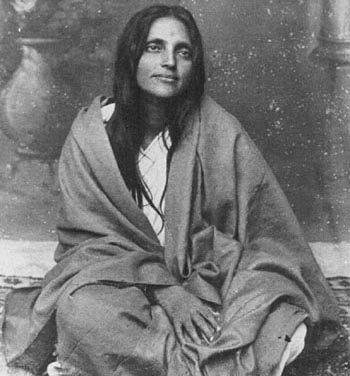Anandamayi Ma
From Thee a cobweb of worlds is spreading out at every moment.
Thou art the dispeller of all fears; do Thou appear before us!
Thou art the seed of the universe; Thou art the Being in whom I reside.
Thou art present in the hearts of all these devotees.
Do thou, whom I find present before me,
banish the fears of all created beings.
Thou art the embodiment of all gods and much more.
Thou hast come out of me and I am the epitome of the created world.
Let us contemplate the very Foundation of this universe,
through Whom the world seeks liberation.
(part of a hymn that came from Ma’s lips in 1929)

Anandamayi Ma around 1920 (public domain)
Born Nirmala Sundari Bhattacharya in Vadyakuta, East Bengal (now Bangladesh), on April 30, 1896, Anandamayi Ma was a mystic considered by her disciples as an avatar of Shakti, the manifest energy of the divine, and as God in the form of the goddess Kali.
Her father, Bipin Behari Bhattacharya, was head of a poor Brahmin family and was often in religious ecstasy as he sang songs from the Vaishnavite tradition. Her mother, Moksada Sundari Devi, also experienced states of religious emotion and reported visits by avatars and deities who appeared surrounded by light. Moksada eventually took vows of renunciation.
As a child, Nirmala also behaved as an ecstatic. She fell into trances, saw visions of religious figures, and gazed into space with eyes not focused on physical objects. Her education was limited and her writing skills minimal. Married at age 13 to Ramani Mohan Chakravarti, she spent a few years living in her brother-in-law’s house, often in a trance. At age 18, when her brother-in-law died, she went to live with her husband; there she met a young man who was impressed by her quiet way of being. He called her Ma (mother in Bengali) and said that one day the entire world would address her with that name. Her marriage remained celibate because Nirmala’s body would grow stiff and faint when her husband approached the topic of sexuality. She would regain normal consciousness only after he repeated mantras He eventually accepted her as his guru and took initiation from her.
Throughout her life, Nirmala exhibited bodily states of trance, physical stiffness, and fainting. She could hold difficult yogic positions (asanas) for long periods and form complex hand positions (mudras) and gestures. After examination by exorcists and physicians, she was diagnosed as having a kind of god intoxication, a divine madness. Her status as a holy woman was based entirely on her spontaneous ecstatic states, as she did not receive formal religious training or initiation from a guru. Instead, she heard voices that told her which spiritual practices to perform and which images to visualize. She would variously shed profuse tears, laugh for hours, talk at great speed, roll in the dust, dance for long periods, and fast for days. At age 26 Nirmala began a stage of spiritual discipline (sadhana) without a guru. She performed her own initiation (diksha), spontaneously visualizing the ritual and initiatory sacred words, after which she entered three years of complete silence. In 1925, Sri Jyotish Chandra Roy named her Anandamayi Ma.
Although her parents worshipped Krishna, Anandamayi is not properly placed in a specific Hindu sect; rather, her influence was felt in many religious traditions of India. She traveled widely, staying at abandoned temples and other inhospitable sites, with little care for her physical body. She taught detachment from the world, religious devotion, and service to others. She was known for her siddhis, or yogic powers, particularly telepathy, healing, and a variety of psychic states. Her chaotic states of consciousness, she believed, derived from spontaneous eruptions of the divine will that arise out of the state of nothingness or the void (mahasunya). She explained that her emotional states were the play of the Lord acting through her body, and that she as an individual person did not exist. She died on August 27, 1982. The Sri Sri Anandamayi Sangha of Varanasi coordinates many ashrams built for her by her disciples throughout India.
( Encyclopedia of Hinduism)
